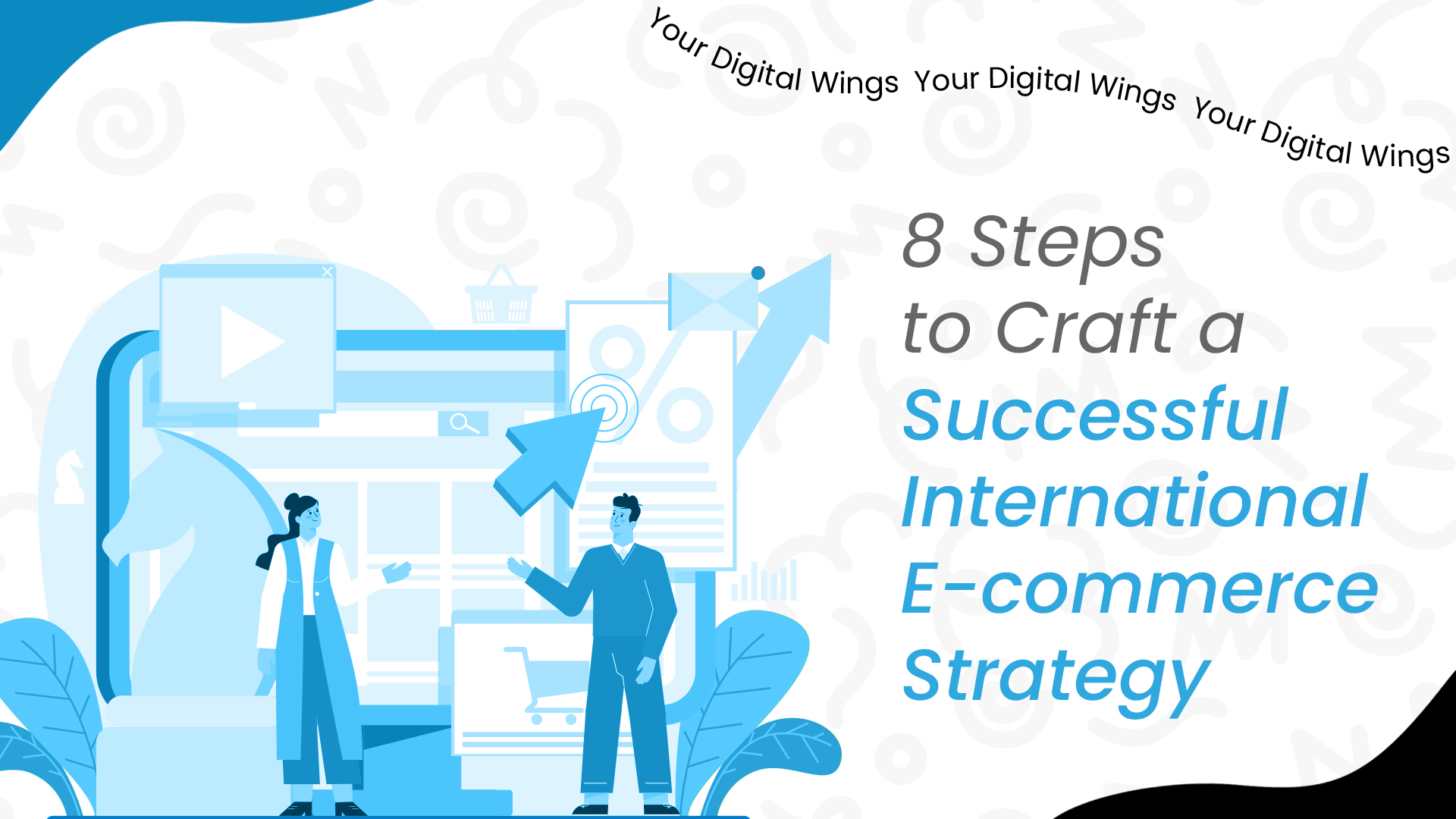In the rapidly evolving world of e-commerce, expanding your business internationally is a powerful way to boost growth and reach new markets. However, the path to International E-commerce strategies success isn’t straightforward. It requires a well-thought-out strategy to navigate the complexities of diverse markets. One common pain point businesses face is the overwhelming challenge of understanding and adapting to different market dynamics, including varying consumer preferences, payment methods, and regulatory environments.
Expanding internationally means dealing with different languages, currencies, and cultural expectations. Businesses often struggle with localizing their content, offering relevant payment methods, and ensuring smooth logistics and compliance with local regulations. Without a strategic approach, these challenges can lead to operational inefficiencies and customer dissatisfaction.
To help you overcome these challenges, we present eight essential steps to crafting a successful international e-commerce strategy. These steps will enable you to effectively tap into the global marketplace, ensuring you meet the needs of diverse customers while maintaining operational efficiency.
Step 1: Utilize Global Marketplaces to Test Demand
Before diving headfirst into a new market, it’s wise to test the waters. Utilizing global marketplaces like Amazon, eBay, and Alibaba can provide valuable insights into the demand for your products. According to a report by eMarketer, global e-commerce sales are projected to reach $8 trillion by 2024, indicating vast opportunities for businesses to explore International e-commerce strategies for international markets. These International e-commerce platforms offer a ready-made audience and can help you gauge interest without significant upfront investment. By analyzing sales data and customer feedback, you can make informed decisions about which markets to target more aggressively.
- Expand Reach
- Analyze Data
- Cost-Effective Testing
Step 2: Offer Diverse Payment Methods Tailored to Each Market
One size does not fit all when it comes to payment methods. Different regions have varying preferences, and accommodating these can significantly boost your sales. Ensure that you offer a range of payment options, including credit cards, digital wallets, and local payment methods. For instance, while credit cards are popular in the US, As of December 2023, around 954 million people used mobile payments in China.. Tailoring your International payment gateway options to match local preferences can reduce cart abandonment rates and enhance customer satisfaction.
- Local Preferences
- Increase Trust
- Enhance Conversion
Step 3: Localize Every Aspect: Language, Currency, and Content
Localization is key to winning over international customers and International e-commerce strategies. This goes beyond just translating your website into different languages. You need to localize your content, currency, and even cultural nuances. A study by the Common Sense Advisory found that 75% of customers prefer to buy products in their native language. Offer prices in local currencies to make transactions easier for customers. Adapt your marketing messages to resonate with local cultures and values. A well-localized website builds trust and makes your customers feel valued.
- Use local languages.
- Show prices in local currency.
- Adapt to cultural norms.
Step 4: Develop International Shipping Capabilities
Shipping can be a major hurdle in international e-commerce, but it’s crucial to get it right. Partner with reliable international shipping carriers to ensure timely and cost-effective deliveries. According to Statista, cross-border e-commerce sales are expected to surpass $4.5 trillion by 2025. Consider offering multiple shipping options, including express and standard shipping, to cater to different customer needs. Transparent shipping policies and tracking options can also enhance the Global customer service strategies and experience, making your international customers feel confident about their purchases.
- Global Logistics
- Customs Compliance
- Tracking & Support
Step 5: Focus on Mobile Optimization
With the majority of global e-commerce transactions happening on mobile devices, optimizing your mobile experience is non-negotiable. According to Shopify, mobile e-commerce sales are projected to reach $3.56 trillion by 2021, highlighting the importance of a mobile-first approach. Ensure your website is mobile-friendly with a responsive design, fast loading times, and an intuitive user interface. A seamless mobile shopping experience can significantly boost your conversion rates, especially in markets where mobile commerce is prevalent.
- Ensure your site adapts to all screen sizes.
- Optimize for quick load times on mobile networks.
- Simplify menus and buttons for easy use on mobile devices.
Step 6: Adjust Your Pricing Strategy for Global Markets
Pricing can make or break your success in International e-commerce strategies. Research local market conditions and competitor pricing to set your prices appropriately. Consider factors such as currency exchange rates, local taxes, and purchasing power. Dynamic pricing strategies and International e-commerce strategies, where prices adjust based on demand and market conditions, can help you stay competitive and maximize profits. For instance, a study by Deloitte found that 60% of shoppers are willing to pay more for products from their preferred brands, emphasizing the importance of strategic pricing.
- Align prices with regional economic conditions and purchasing power.
- Account for exchange rates and currency fluctuations.
- Adjust pricing based on local competitors’ International e-commerce strategies.
Step 7: Implement Automation Tools for Compliance
Navigating international regulations can be daunting, but automation tools can help ensure compliance with ease. Use tools for tax calculations, customs documentation, and regulatory compliance to avoid legal pitfalls. These tools can also streamline your operations, reduce manual errors, and save time, allowing you to focus on growing your business. According to a report by McKinsey, automation can reduce operating costs by up to 20%, making it a valuable investment for international e-commerce.
- Regulation Tracking
- Document Management
- Reporting
Step 8: Tailor Customer Service to Local Expectations
Excellent customer service is a cornerstone of successful e-commerce. When expanding internationally, it’s essential to understand and meet local customer expectations. Offer customer support in local languages and be aware of cultural differences in communication styles. Providing localized support through various channels, such as live chat, email, and social media, can enhance customer satisfaction and loyalty. According to HubSpot, 93% of customers are likely to make repeat purchases with companies that offer excellent customer service, underscoring the importance of tailored support.
Train staff to understand and respect local customs and communication styles.
Offer customer service in local languages for clearer communication.
Adapt service processes to align with regional customer preferences and expectations.
How Cretesol Tech Can Support Your International E-commerce Efforts
At Cretesol Tech, we understand the challenges of international e-commerce and offer tailored solutions to help you succeed. Our services include market analysis, localization, payment gateway integration, and international shipping partnerships. We provide comprehensive support to ensure your business is equipped to thrive in the global marketplace. Let us help you navigate the complexities of international e-commerce and achieve your business goals.
Importance of crafting a successful international e-commerce strategy:
| Aspect | Importance |
| Global Market Reach | Expand your business reach to a larger audience, increasing potential customer base and sales opportunities. |
| Revenue Growth | Tapping into international markets can significantly boost revenue and profitability. |
| Brand Recognition | Enhances brand visibility and recognition on a global scale, establishing a strong international presence. |
| Competitive Advantage | Staying ahead of competitors by offering localized and tailored experiences for diverse markets. |
| Market Diversification | Reduces dependency on a single market, spreading risk and increasing business stability. |
| Customer Insights | Gathers valuable insights into customer preferences and behaviors across different regions, informing better business decisions. |
| Adaptation to Market Trends | Staying agile and responsive to global market trends, ensuring your business remains relevant and competitive. |
| Regulatory Compliance | Ensures compliance with international regulations, avoiding legal issues and potential fines. |
| Efficient Operations | Streamlines operations with automation tools, reducing costs and improving efficiency. |
| Customer Satisfaction | Enhances customer satisfaction by providing localized services, support, and payment options, fostering loyalty and repeat business. |
Conclusion
Expanding your e-commerce business internationally can be a game-changer, but it requires a strategic approach. By following these eight steps testing demand, offering diverse International payment gateways methods, localizing your efforts, developing robust shipping capabilities, optimizing for mobile, adjusting pricing and International e-commerce strategies, using automation tools, and tailoring customer service you can build a winning international e-commerce strategy.
With the right preparation and support, the world is your marketplace. Cretesol Tech offers comprehensive services including market analysis, localization, payment gateway integration, and international shipping partnerships to help you navigate the complexities of international e-commerce. Let Cretesol Tech be your partner in achieving global success.
FAQs
What are e-commerce strategies?
International e-commerce strategies are plans and approaches designed to enhance the online selling process, attract customers, and increase sales. These strategies cover various aspects such as marketing, customer service, payment options, and logistics.
What is international e-commerce?
International e-commerce refers to the process of selling products or services online to customers in different countries. It involves dealing with various challenges, including different currencies, languages, and regulations.
What are the three strategies that are required for e-commerce success?
The three key strategies for e-commerce success are: offering a seamless and user-friendly online shopping experience, employing effective digital marketing techniques, and ensuring efficient logistics and customer service.
What is global e-commerce?
Global e-commerce is the buying and selling of goods and services across international borders through online platforms. It enables businesses to reach a worldwide audience and expand their market presence beyond their home country.

 United Arab Emirates
United Arab Emirates